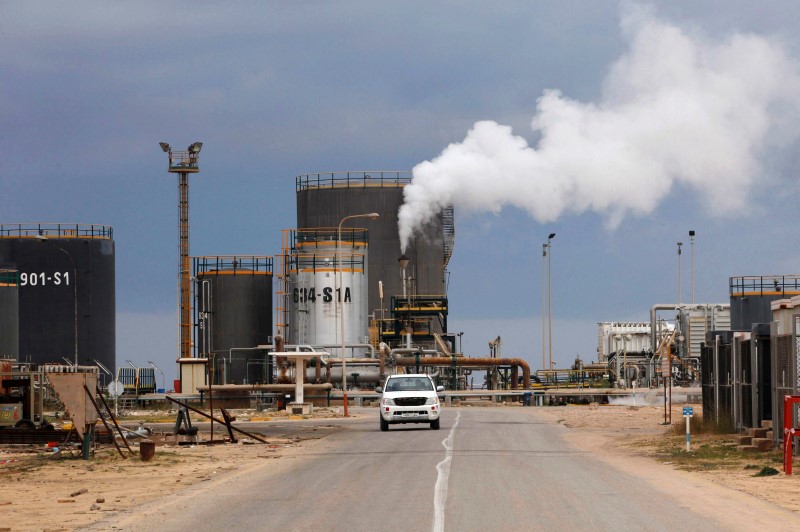* Biggest quarterly loss for Brent since Q4
* For Q3, Brent posts 8.7% loss, WTI down 7.5%
* Chinese exports fall for 16th month
* Aramco restores capacity to pre-attack level -trading unit chief
* Reuters poll sees oil prices steady through 2019 (Updates prices to settlement, adds milestone on quarterly price decline, adds U.S. production data and OPEC output polls)
By Collin Eaton (NYSE:ETN)
HOUSTON, Sept 30 (Reuters) - Oil prices fell on Monday on fading concerns of supply shortfalls and conflicts in the Middle East after the Sept. 14 attack on Saudi Arabia, but global benchmark Brent posted its biggest quarterly loss this year on demand fears due to the escalating U.S.-China trade war.
Brent crude LCOc1 futures settled at $60.78, down $1.13, or 1.8%. U.S. West Texas Intermediate (WTI) crude CLc1 futures, the U.S. benchmark, fell $1.84, or 3.3%, to $54.07.
Brent gained 0.6% while WTI fell 1.9% in September after volatile month where prices spike nearly 20% after the attacks halved Saudi Arabia's output, but have pared nearly all those gains as output has been quickly restored.
For the quarter, however, global benchmark Brent fell 8.7%, the worst quarterly drop since the fourth quarter of 2018, when prices dropped 35%.
WTI also dropped 7.5% in the third quarter, as concerns that the trade war between the United States and China has plunged global economic growth to its lowest levels in a decade weighed on oil demand growth.
China's official Purchasing Managers' Index (PMI) was slightly improved this month, increasing from 49.5 in August to 49.8 in September, but remained below the 50-point mark that separates expansion from contraction on a monthly basis, data from the National Bureau of Statistics showed. the world's largest crude importer, warned of instability in international markets from any "decoupling" of China and the United States, after sources said U.S. President Donald Trump's administration was considering delisting Chinese companies from U.S. stock exchanges. U.S. and China are still far from any type of agreement. The concern is oil demand is not going to be there," said Kyle Cooper, an oil analyst at IAF Advisors.
Saudi Aramco last week restored full capacity to the level before the attacks on its oil facilities, Ibrahim Al-Buainain, chief executive officer of its trading arm, said on Monday at a conference in the United Arab Emirates. oil output capacity was restored to 11.3 million barrels per day (bpd) after the attack knocked out 5.7 million bpd of the kingdom's output, sources told Reuters last week. Saudi officials said Aramco will reach 12 million bpd of capacity by November. "much quicker than expected return of Saudi oil (supply) as we go into refinery maintenance season" was weighing on prices, said Andy Lipow, president of Lipow Oil Associates in Houston.
After the attacks, OPEC's oil output fell to an eight-year low in September, a Reuters survey found. Output was 29.8 million bpd in September, down 750,000 bpd from August. fears of broader escalating tensions in the Middle East after Saudi Arabia and the United States blamed the attacks on Iran, have also faded somewhat, easing upward pressure on prices, analysts said.
Saudi Arabia's Crown Prince Mohammed bin Salman, often referred to as MBS, said in an interview broadcast on Sunday he would prefer a political solution to a military one in response to attacks. he warned oil prices could spike to "unimaginably high numbers" if the world does not come together to deter Iran.
Money managers cut their net long U.S. crude futures and options positions in the week to Sept. 24, the U.S. Commodity Futures Trading Commission (CFTC) said on Friday. long as peace breaks out in the Middle East, we'll see oil continue to trade lower," said Robert Yawger, director of energy futures in New York.
Oil prices are likely to remain steady this year, a Reuters survey showed, with supply shocks such as the attack on Saudi Arabia countering flagging demand.
Analysts forecast that Brent crude would average $65.19 a barrel in 2019 and WTI $57.96. oil production fell 276,000 bpd in July to 11.81 million bpd, a third monthly decline since its record at 12.1 million bpd in April, government data showed.
